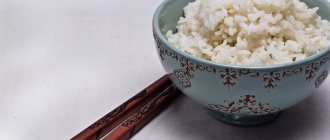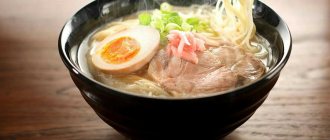Dedicated to all lovers of light, nutritious dishes rich in minerals and vitamins - today we will talk about Asian cuisine. And to be absolutely precise, we are interested in the Japanese breakfast, because the day begins with the morning meal, so it is especially important. In this article we have selected for you recipes for simple but healthy, and, most importantly, authentic oriental dishes for your morning.
Different countries treat breakfast differently. Somewhere they forget about it, somewhere they limit themselves to a cup of Americano or espresso, somewhere they crunch on corn flakes with milk - everyone chooses something different.
In Japan, the tradition of the first meal is still strong. There you clearly know what products are served for breakfast, so at home it will be easy to join the national flavor and treat yourself to traditional Japanese dishes on a weekend or vacation morning.
The menu consists of rice, eggs - tamagoyaki (omelet roll), miso soup, fish and various tsukemono marinades. As you can see, the list is quite extensive and despite all the apparent lightness of the products, it is difficult to remain hungry after such a meal.
Japanese preferences
The Japanese prefer to eat everything fresh and natural, preferably without any or minimal processing. High quality products come first for them.
A huge variety of seafood is used in the diet.
When serving food, the Japanese are content with the principle “portion sizes are smaller, but more varied.”
What do the Japanese eat? Of course, the main component of many dishes in Japan is rice with a higher stickiness than normal. This allows you to eat it with chopsticks (as is customary for the Japanese).
Almost everything is eaten from seafood: fish, sea animals, algae, shellfish, and so on. Moreover, most are consumed raw.
Very often, Japanese dishes use soy, which is highly processed to produce soy sauce, soy milk, miso, tofu, yuba, natto and edamame.
Beans, lettuce, carrots, cabbage, cucumbers, wasabi, bamboo, daikon, lotus and so on are also widely used in Japanese cuisine.
Three-thirds rule - Japanese breakfast
- Where? Where are you going? What about breakfast? Everything is already on the table. - Then I’ll have breakfast. - When later? - In the evening!
She was right, my grandmother, who was blocking my escape from the kitchen, saying:
— Breakfast is the foundation on which you build your day. You know: “Eat breakfast yourself, share lunch with a friend, give dinner to your enemy.
After kicking for the first ten years of my life, I began to live according to my grandmother’s behests. True, with a small amendment: do not give dinner to your enemies. They will be spoiled and will not leave you alone.
In 2013, UNESCO awarded Washoku Japanese cuisine cultural heritage status. It is surprising that this was not done earlier, because it is no coincidence that this nation holds the palm in longevity.
I just need to find out their secrets, because I have so many things planned that even at seventy years old I won’t be able to complete them.
Let's start with the main thing. From what we will build our day on.
What does a typical traditional breakfast in Japan consist of? Well, of course, rice and fish. The richer you are, the happier you are. There is always rice in a Japanese family. Most often, it is served hot in a Suihanki, a rice cooker that the Japanese invented in the forties of the last century and are now replicated around the world under the name Multicooker. Or in a Do-nabe ceramic saucepan with two lids. Cooked without oil or salt. Not very sticky, but not crumbly either. Served in a special rice bowl - Chawan.
Unlike Korea, where it is considered bad manners, in Japan it is customary to take a bowl of rice in the hand, grabbing the rice with chopsticks, sometimes sprinkled with Furikake - dried or salted seaweed, vegetables, sesame seeds, fry or krill. Therefore, the cup of rice is always placed on the left.
I am fascinated by the harmonious system that combines the ergonomics of Japanese dishes, the rules for placing them on the table and the traditional manner of using them. There is a reason for everything and there is an explanation for everything.
Japanese breakfast differs from breakfasts of other national cuisines in that a balanced set of several dishes is served at one meal - Tei-shoku, each of which is not usually used separately. They are like instruments in an orchestra, creating harmony together.
The main rule: One to three - Ichi ji san sai. That is, three additional dishes should be served with one cup of rice. One main (usually a source of protein) and two vegetable.
The second pillar on which the traditional breakfast rests is Yaki-zakana - grilled fish.
All gas stoves produced in Japan are equipped with a grill; Yaki-zakana, cooked without a drop of oil, occupies such an important place in the Japanese diet.
Seasonality is strictly observed. Every month brings its own variety of fish. Nowadays it's saury. Unlike caught in the summer or spring, it is now simply filled with amber fish oil. Fish fins are traditionally rubbed with salt.
The aesthetics of serving food on the table has its own canons. One of them is keeping the fins, head and tail intact. This indicates the freshness of the fish (even though everything we eat is usually caught within two to three days) and pleases the eye with its natural beauty.
To prevent the skin from cracking, leaving an unsightly ragged break, it is cut crosswise. First, the side is fried, which will be exposed when served, then the one that will be hidden from the eyes of the eater.
Whole fish always “swims” from right to left, that is, it is served with its nose towards the cup of rice, with its back away from the eater. This way it looks visually better, in addition, table manners require eating fish with chopsticks, from left to right. It is more convenient to do this starting from the head.
Most often, Japanese Daikon radish, grated on a very fine grater, is served as an accompaniment to baked fish. The juice is carefully squeezed out, a neat slide is formed, which is located at the tail of the fish. The top of the radish hill is sprinkled with soy sauce.
The third constant component of breakfast is Miso soup. It cooks faster than fast. Exactly as much as is needed to boil water, because all the ingredients are cut very thinly and cooking them takes no more than two minutes.
Very often, the lack of salt in rice is balanced by pickled, salted or pickled vegetables - Tsuke-mono, which are always in the refrigerator of the Japanese housewife. But their volume does not exceed the size of two thimbles.
Soy products are a frequent guest on the breakfast table. It could be soft Tofu soy cheese or Natto fermented beans, the quiet horror of any foreigner who learns that sticky, rotten beans have been served on the table, which cannot be brought to the mouth without getting dirty with sticky threads trailing behind the chopsticks.
An approximate weekly menu from the repertoire of a working mother.
It took no more than 15 minutes to prepare each of the presented breakfasts.
Option #1
- Rice with Ume-boshi - pickled green apricot,
- Miso soup with mushrooms,
- Saira,
- Tofu with ginger and soy sauce.
Option No. 2
- Rice topped with dried baby fish and shrimp
- Miso soup with Asari clams and green onions,
- Sesame seed tofu and Kuchu root powder,
- Natto Fermented Beans,
- Barley tea.
Option #3
- Hijiki Seaweed Rice,
- Pickled daikon radish,
- Miso soup with Wakame seaweed and tofu,
- Grilled mackerel,
- A piece of Japanese Tamago-Yaki omelette.
Option No. 4
- Rice from this year's harvest, boiled with the "gifts of the season": carrots, bamboo, mushrooms, lotus roots, spinach and chestnuts,
- Miso soup with seaweed, green onions and dried gluten,
- Chum salmon baked with green peppers and onions Negi,
- Cucumbers marinated in Perilla juice, with ginger and pepper,
- Hanpen is a product made from a mixture of shark pulp, mountain potatoes and egg whites with daikon radish sprouts.
Option #5
Ocha-zuke is a quick breakfast option when you don’t even have five minutes to prepare.
Rice sprinkled with a mixture of dried vegetables, fish flakes, green tea, dried seaweed and Kamaboko fish paste.
Usually served in the evening, after a heavy meal and serious alcoholic libations, to mitigate the destructive consequences for the body.
Also interesting: How to replace potatoes
Which is better to cook - boil or fry?
But the main art of the Japanese breakfast is to have time to run to work, leaving the washing up, all these “one plus three” plates, multiplied by the number of eaters, to these same eaters. published by econet.ru
Author: Elena Eresan
PS And remember, just by changing your consumption, we are changing the world together! © econet
econet.ru
Japanese breakfast
Breakfast is very important for the Japanese. After all, it is the very first meal at the beginning of the day that gives the body vigor and good mood for the whole day. The Japanese breakfast includes rice and natto (soybeans placed on top of rice). Natto is notable for being rich in plant-based protein. This allows you to satisfy your hunger for a long time.
In addition to rice and natto, the Japanese prepare an omelet for breakfast, which is rolled into a roll. Soy sauce and a little sugar are added to it. This dish is called tamago-yaki.
Miso soup (misoshiru) is very popular in Japan. This is a soup made from miso paste. Wakame seaweed, tofu cheese and other ingredients are added to it. Depending on the time of year and the territory of the country, the ingredients can be varied.
The Japanese also serve pickled vegetables (tsukemono) for breakfast. They add little salt and are not cooked. This allows you to preserve all the beneficial substances in vegetables.
The Japanese prefer healthy green tea as a breakfast drink.
Japanese breakfast dishes are distinguished by the fact that they are quite nutritious and give you energy for the whole day.
How to cook rice for breakfast
To have a proper Japanese breakfast, you need to know how to cook rice for it. When finished, this cereal should not be sticky, but moderately crumbly. The ideal consistency of rice is such that it can be eaten with chopsticks - it is in this form that it is especially useful for the human body (it is not necessary to eat it with chopsticks, but determine the appropriate consistency based on this factor).
Why flights from Russia to the USA are dangerous to health
How dirty are wooden spoons? A water test will help you check (video)
I love homemade milk and chocolate baths: the skin is moisturized and I relax
Japanese lunch and dinner
For lunch, the Japanese cook light food. As always, the basis is rice. It is served with fish in any form (marinated, grilled or raw). Additionally, salads or boiled vegetables are served. Soy sauce or rice vinegar is used to dress salads.
The preferred drink is tea.
But mayonnaise, beloved by many Europeans, is almost never used by the Japanese.
The Japanese dinner is hearty. As usual, it's rice or noodles. Fish, vegetable or meat soups are also consumed. Moreover, the Japanese do not use spoons. First, pieces of meat and vegetables are caught with chopsticks, then the broth is drunk directly from the bowl.
Steamed vegetables, meat, fish, and pickled snacks can also be served for dinner.
For dessert they eat wagashi, made from rice or legumes, gelatin, herbs, and fruits.
Below we will look at how to prepare onigiri - a dish of rice and various fillings. It is used for breakfast, lunch and dinner.
Types of breakfasts according to the “Bed Breakfast” type
Exactly what foods are served for breakfast depends on the country, region, and even individual province. B&B owners create a menu at their own discretion, giving preference to traditions or generally accepted food standards. The proposed diet includes local products, without delicacies or “overseas” ingredients, since the “breakfast only” format refers to budget options for entertaining guests. You shouldn’t count on any delicacies or delicacies; everything here is subject to simplicity, quick service and convenience for both residents and staff. Some hotels offer special types of menus to guests - dietary, children's, kosher, etc.
The most popular are the basic types of breakfast. They do not contain alcoholic or low-alcohol drinks.
- Continental Breakfast (CB, CBF, CP)
This type of morning nutrition is common in different countries of the world, although it applies to European and Mediterranean countries. The British called the breakfast “continental” to distinguish it from their more hearty “island” breakfast.
A continental breakfast includes tea, coffee, hot chocolate or a glass of juice, sweet pastries or sandwiches, and portioned packets of honey or fruit jam. Milk or yogurt is often offered. An extended continental breakfast is complemented with cereals or muesli, cold cuts and cheeses, boiled eggs, and cottage cheese.
- English Breakfast (EB)
Unlike a light continental breakfast, an English breakfast is richer and larger. Guests can enjoy bacon bits or bangers, scrambled or boiled eggs, mushrooms, buttered toast or scones, grilled tomatoes, tea or coffee. In addition, the menu may include black oatmeal pudding with beef liver or baked beans.
In Cornwall you will be offered potato cutlets, in Ireland - “breakfast roll”, which is a baguette or buns filled with fried ingredients of a traditional Irish breakfast, or pork sausages with oat pudding, in Ulster - white pudding, soda or potato bread, and in Wales - Welsh dishes.
Photo: © stockcreations
- American Breakfast (AB, AB F )
American breakfast differs from its English counterpart in even greater density. Guests are offered to try pancakes topped with maple sauce, french fries or hash browns, toasted muffins with different fillings or toast with butter, poached eggs or scrambled eggs with bacon or ham, buns or sandwiches with sausage and cheese, and topped with yogurt. muesli with fruit.
One of the varieties of American breakfast is the burrito, which is more related to Mexican cuisine and street food. These are fried foods, seasoned with sauce and wrapped in thin tortillas. There is usually cheese and chili inside. The range of drinks traditional for a continental breakfast is diluted with freshly squeezed juices, fruit or vegetable smoothies.
- Vegetarian and gluten-free breakfasts
B&B owners do not often pamper their guests with diet breakfasts, but when booking a hotel you can find special meal offers. For vegetarians, meals are made from plant-based products, without meat or eggs, and for those suffering from gluten intolerance - without ingredients containing gluten. Similar breakfasts are offered in more expensive hotels.
- Asian breakfast
This term is a general one, since Asian cuisine is very diverse. The main products are rice and noodles, cooked with seasonings, including spicy ones. And although the dishes themselves contain little fat, they are often deep-fried with copious amounts of vegetable oil. Asian breakfasts are not for everyone.
Strange Japanese dishes
Japanese food (cooking recipes below) is diverse and strange. There are some dishes that people from other countries find disgusting. Among them are the following:
- Grated Japanese yam, which is unpleasantly slippery.
- Uni are the genital organs of sea urchins.
- Habushu is sake (a strong drink) with a viper inside.
- Shiro no odorigi is a writhing fish with a quail egg, served alive.
- Shiokara is squid marinated in giblets.
- Natto is smelly, sticky soybean.
- Black sulfur noodles are noodles boiled in sulfur.
- Zazamushi are larvae of insects living in the river.
- Fugu is the most poisonous fish.
- Shirako is cod sperm eaten either raw or cooked.
Despite the strangeness of Japanese food recipes, it is known that the Japanese differ from the inhabitants of other countries in their good health and longevity. The naturalness of the products and the minimum of their processing make themselves felt.
Forms of serving breakfast
The most popular is the beloved buffet, or breakfast buffet. Several dishes are displayed on counters or tables, and guests themselves choose what they like. There are varieties of buffet when:
- any amount of food available (“all inclusive”) with multiple or single approaches;
- a limited assortment of menus or serving sizes is provided (most often found in B&B);
- the guest fills the plate himself or his choice is served by the server/waiter.
Breakfasts often include the preparation of coffee or tea by the owner of the B&B or one of his assistants. But sometimes guests are provided with only boiling water, and they brew their own drinks from bags. Small guest houses may offer to set communal tables at a certain time, which is very convenient for one company. Breakfast in larger hotels is often brought to your room in special containers.
Breakfast formats - in the dining room or your room, at the bar, in the owner’s kitchen, in a cozy courtyard, at a separate or shared table.
How to cook onigiri?
Very often the Japanese prepare a dish called onigiri. It is similar to sushi and rolls, but easier to prepare. It is important to choose the right rice. It should be sticky. First, boil the water. The rice is thoroughly washed 6-8 times, then placed in boiling water. Do not add salt to the water. The product should be fresh. Cook for 5-7 minutes on medium power, then 10 minutes on low heat. Turn off the stove and leave the rice to cook to the desired state for about 20 minutes.
Next, triangles or balls are formed from the finished rice, inside of which you can put some filling (you can do without it). A substrate is made from algae on which the finished rice triangles are placed.
You can use cling film to form triangles. Better yet, use special molds.
Rules for guests
For breakfast in the common food area, it is not customary to appear bare-chested, in shorts or a swimsuit, or in evening or provocative outfits. In most cases, you are not allowed to take food into your room, but there are exceptions where eating is allowed in the room.
No one obliges guests to arrive at the start of breakfast, since its duration is usually about two hours. However, showing up a few minutes before the end of the allotted time is considered bad manners. Don't forget that the staff's job is not just to feed you, so be respectful.
Remember that the buffet is created for the convenience of guests, and not for overeating, especially in the morning. Take only the essentials so that your plans for the day are not disrupted by drowsiness that comes after too rich meals.
For takeaway breakfasts, there is an unwritten rule - you should not take more than the serving per person, since the amount of food always corresponds to the number of guests. Taking too much means leaving someone without food.
Onigiri filling
The Japanese use various seafood as fillings: salmon, caviar, shrimp, tuna. Onigiri with salted plums is very popular. Also used are meat, chicken, fresh or pickled vegetables, seaweed, cream cheese and salmon. The filling can be put inside, or you can mix it with rice and only then form triangles (balls).
If desired, you can add soy sauce or sesame oil to the rice.
Before serving, onigiri can be decorated with sesame seeds, pieces of fruit, seaweed, and vegetables.
Instead of using a bed of seaweed for the rice triangles, you can make an omelette to wrap them in. To prepare it you will need an egg, mayonnaise and starch. Beat them into a homogeneous mass, add salt and pepper and fry in a frying pan on both sides.
Onigiri
If plain rice, even with additional dishes on the table, seems bland and uninteresting to you, make onigiri from it. This is a traditional Japanese dish, extremely popular in its homeland.
All you have to do is choose the appropriate filling, form a triangle around it and wrap it in nori seaweed. It's not difficult - we take warm rice into a clean palm and give it a suitable shape. Inside you can put anything you want - from tuna or salted salmon, to cucumbers, omelette and shrimp.
Unusual dish - tamagoyaki
The Japanese have such a dish as Japanese tamagoyaki, which is loved by many. This is an omelette with a sweetish taste, prepared in a special way. Many children love it for its sweet taste. The cooking technique is simple.
Take five eggs and beat lightly (30 seconds on low mixer power). Next you need to strain them through a sieve. Then add soy sauce (1.5 teaspoons), sugar (1 tablespoon), rice vinegar (1 tablespoon). Mix everything thoroughly. Next, frying the omelet begins. It is advisable to use a square pan. The fire should not be strong. Pour the egg mixture in a thin layer and, as soon as it sets, roll the omelette into a roll and leave it on the edge of the pan. The egg mixture is poured into the free space again, and the first finished roll is rolled into the second. The procedure is repeated three to four times. It turns out 3-4 layers of omelet in a roll. The resulting roll is cut into portions. The dish can be served with ginger, wasabi, daikon and so on.
Although most Japanese food recipes use rice and soy, Japanese dishes are varied and beautifully presented.
Rice
Rice was, is and will be the basis of Japanese cuisine. Despite the fact that more and more Japanese people eat European food, this cereal continues to occupy the main place on the table. Without it, no breakfast, lunch or dinner will be considered complete and complete.
Simple is considered classic. It is worth noting that if the variety is chosen correctly, even without salt, spices and oil, the dishes will turn out incredibly tasty. The main condition for real Japanese rice is its consistency; it should turn out crumbly.
To do this, rinse a glass of long white rice (preferably Jasmine - it turns out very aromatic). We do this until the water becomes completely transparent - it may take seven or even nine “washes”. Transfer to a saucepan and pour in 1.25 tbsp. water. If we have less rice than a glass, there should also be less water, but always exactly a quarter more than cereal - this is the main condition.
Bring to a boil without a lid over high heat, then reduce it and cover the pan. Cook for 15 minutes without opening, and then, removing from heat, keep for another 10, also covered. Breakfast side dish is ready!
Breakfast in the South of Europe
Residents of Southern Europe are not particularly inventive when it comes to their morning meals. A typical breakfast takes only 10 minutes and includes quick and quite harmful, but delicious carbohydrates.
- The French “little breakfast” is crispy croissants and a cup of hot chocolate or coffee
- The Spanish morning meal consists of traditional churros (fried puff pastry sticks filled with chocolate) and aromatic coffee. Children are offered freshly squeezed orange juice
- In Greece, the usual cappuccino is served with a national dish - bougatsa. This is a layer pie with different fillings: light with cheese, custard or nutritious with spinach and minced meat.
- The Portuguese's favorite morning treat is pastel de nata (light custard buns) and a cup of cocoa.
By the way, breakfast in the Benelux countries (Luxembourg, Belgium, Holland), despite their geographical location, resembles a morning meal in Southern Europe. These are the famous Belgian waffles, eaten with marmalade, plus tea, coffee or cocoa.
Asian breakfasts
Thin rice porridges, vegetable stews and various seafood soups are the basis of any breakfast in most Asian countries.
- In Japan, they often have the national miso soup for breakfast. The dish consists of seafood, rice noodles, soybean paste and tofu
- The traditional morning soup in Vietnam is pho. This is fish broth with vegetables, herbs and rice noodles
- In China, breakfast is served with congee with pickled vegetables and clear noodles. The second option is the famous Chinese dim sum dumplings with meat broth
- In India, vegetable soups are eaten with idli (spiced rice cakes) or khichri (boiled lentils with spices and rice)
- In Malaysia they serve nasi lemak. This is liquid rice cooked in milk with the addition of anchovies, cucumbers and roasted peanuts.
Despite their love for soups, residents of East and Southeast Asia are gradually becoming victims of globalization. This directly affects their daily diet: in large cities and metropolitan areas, they are increasingly choosing a Western style breakfast - buttered toast, scrambled eggs and coffee.
Breakfast in North America
The morning meal of North Americans is simple and monotonous. Residents of Canada and the USA eat for breakfast what they did not have time to eat in the evening. Often breakfast consists of fast food - the beloved, but not at all healthy, fried potatoes, hamburgers, buttery donuts and instant coffee. If there is at least a little time left for cooking in the morning, then the table can be decorated with an omelette with bacon, pancakes with jam or syrup, potato cutlets, and cereal with yogurt.
Breakfast in Mexico is a traditional tortilla, beans, meat goulash and eggs. They are served with hot and spicy sauces, baked goods and juices.










